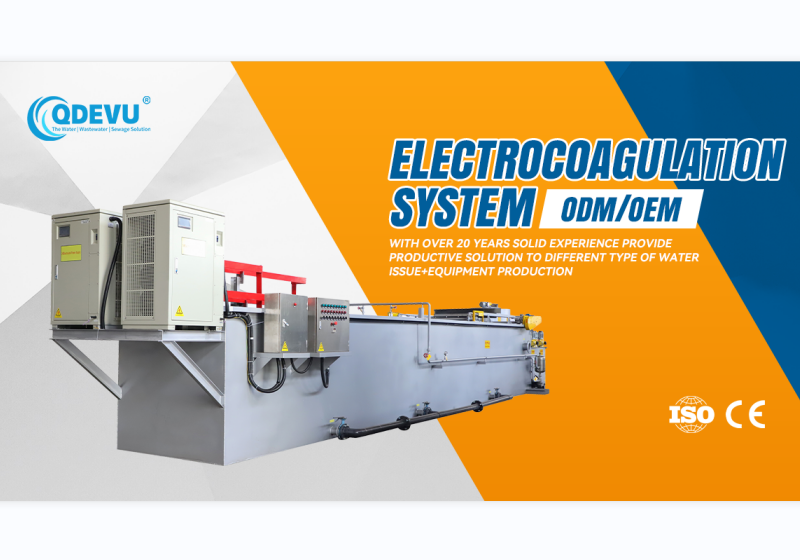Electro-coagulation system in Printing and Dying Wastewater Treatment
There are efficient methods of printing and dying wastewater treatment, here we focus on the role of electro-coagulation system in wastewater treatment.
About the printing and dyeing wastewater
The printing and dyeing wastewater is the wastewater discharged from the printing and dyeing plants that mainly process cotton, hemp, chemical fiber and their blended products.Characterized by large amount of water, high content of organic pollutants, large alkalinity, and great changes in water quality.
Chemical treatment methods
Chemical treatment methods include Neutralization, Coagulation,Oxidation and so on.
1. Neutralization method: In printing and dyeing wastewater, this method can only regulate the PH of wastewater, and cannot remove pollutants in wastewater. When using biological treatment method, the PH before entering the biological treatment equipment should be controlled between 6-9.
2. Coagulation Method: Chemical agents are used to combine a large number of dyes, detergents and other particles in the wastewater to form large particles for removal. Coagulants used in the treatment of printing and dyeing wastewater include basic aluminum chloride, polyacrylamide, aluminum sulfate, alum, ferric chloride, etc.
3. Air floatation Method: Printing and dyeing wastewater contains a large number of various oils and fats with colloidal particles in the form of emulsions. The flocs formed by coagulation of these impurities are small, light in weight and poor in sedimentation performance, and can be separated by air floatation method; At present, in the treatment of printing and dyeing wastewater, the air flotation method has the tendency to replace the sedimentation method, and is a main treatment method of printing and dyeing wastewater. In the treatment of printing and dyeing wastewater, the pressurized dissolved air flotation method is mainly used.
4. Electrolytic Method: This method has good decolorization effect. For printing and dyeing wastewater such as direct dyes, media dyes, sulfide dyes and disperse dyes, the decolorization rate is more than 90%, and for acid dye wastewater, the decolorization rate is more than 70%.
5. Adsorption Method: The adsorption method is very effective for the removal of COD and BOB from printing and dyeing wastewater. Due to the large investment in activated carbon adsorption, it is generally not given priority. In recent years, activated porous materials such as peat, diatomite and kaolin have replaced activated carbon for adsorption. Active adsorption materials with well-developed filter holes should be selected for printing and dyeing wastewater.
6. The oxidation decolorization efficiency is low, only 40-50%, and the coagulation decolorization efficiency is high, up to 50-90%. However, after treatment with these methods, the effluent still has a deep chroma, and further decolorization treatment must be carried out. At present, the methods used for dehydration of printing and dyeing wastewater mainly include photooxidation, ozone oxidation and chlorine oxidation. Due to price and other reasons, the chlorine oxidation method is the most widely used, and its commonly used oxidants include liquid chlorine, bleaching powder and sodium hypochlorite, This method is less suitable due to high processing cost and high operating conditions.
Electro-coagulation system
The QDEVU Electrocoagulation System is a cutting-edge solution that combines three powerful wastewater treatment methods – Electrolysis, Flocculation, and Air Flotation. This system effectively removes a variety of pollutants from contaminated water, including COD, BOD, suspended solids, grease, turbidity, chromaticity, heavy metal ions, calcium, and magnesium ions, among others.
By using advanced electrolytic flocculation technology, the system can coagulate and precipitate colloidal impurities and suspended impurities, while also oxidizing pollutants through the anode and reducing them through the cathode. As a result, it can improve the B/C value of biochemical treatment and enhance the overall efficiency of wastewater treatment across various industries.
APPLICATION
The QDEVU Electrocoagulation System is highly versatile and can be applied to a wide range of wastewater treatment scenarios, including electroplating wastewater, car washing wastewater, textile bleaching wastewater, paper mill wastewater, slaughtering wastewater, and food and beverage factory wastewater, among others. It is also ideal for treating difficult-to-treat sewage sources such as waste leachate sewage, agricultural wastewater, sewage from cooling towers, and mining wastewater.
Furthermore, the system is equally effective in treating wastewater from various recreational sites and maritime activities, such as sewage purification at the bottom of ships and port catchment areas. Overall, the QDEVU Electrocoagulation System is a reliable, efficient, and sustainable solution for treating industrial and municipal wastewater, ensuring safe and clean water for our communities and the environment.
#QDEVU #WATERTREATMENT #WASTEWATERTREATMENT #SEWAGETREATMENT #SEWAGEWATERTREATMENT #WATERFILTER #WATERFILTRATION #SLUDGETREATMENT #SLUDGEDEWATERING
Visit www.evuchina.com for more information!



